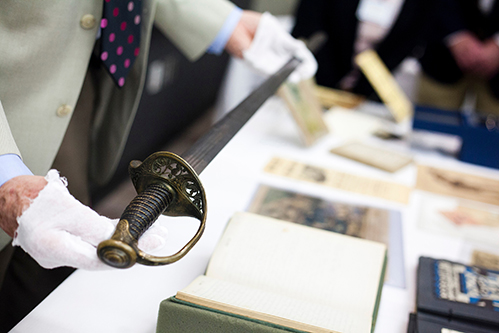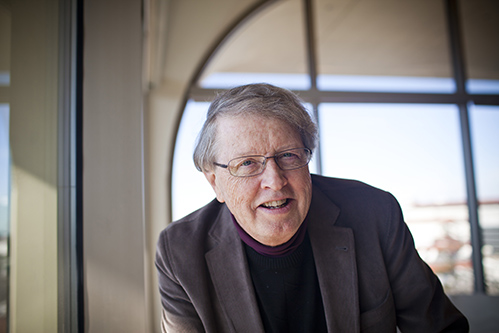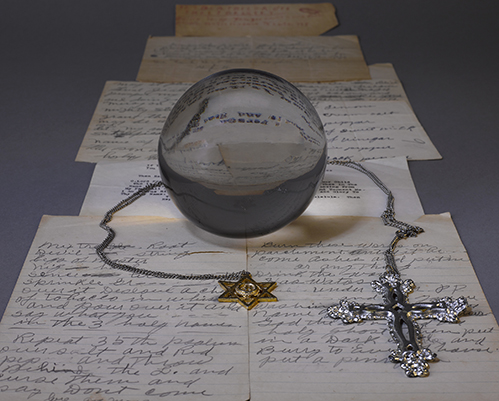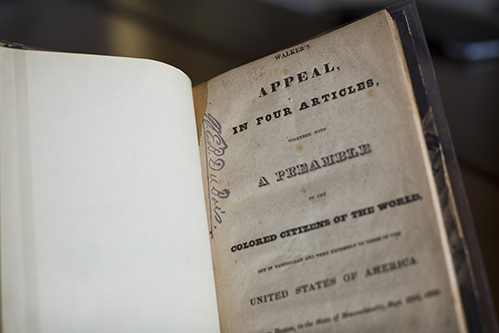In his 21 years at Emory University, Randall K. Burkett has been responsible for acquiring a collection of rare books, manuscripts, serials, photographs,

Randall Burkett holds a Confederate sword from the William H. Scott collection. Scott, a Union soldier and former slave, took the sword from a dead Confederate soldier during a lull in the Battle of Fredericksburg. Credit: Emory Photo/Video, Emory University.
and print ephemera for the Stuart A. Rose Manuscript, Archives, and Rare Book Library. “Building Emory’s African American Collections: Highlights from the Curatorial Career of Randall K. Burkett,” an exhibition that opens Sept. 13, 2018, at Emory’s Woodruff Library, will feature treasures from those collections and Burkett’s stories of their discovery and acquisition.
“We have one of the most extensive archives of African American history and culture among major research universities,” Burkett says. “I’ve been fortunate to build relationships with wonderful people—authors, artists, leaders in their fields, and families—who were looking to place their papers with a library that would preserve them and open them to academic researchers and the public. And that place is the Rose Library at Emory University.”

Randall Burkett, Rose Library curator of African American collections. Credit: Emory Photo/Video, Emory University.
Hired in 1997 as Emory’s first curator for African American collections, Burkett and his library colleagues have sought to ensure the African American voice is represented and have given priority to African American-authored and African American-published material.
“Randall Burkett is the consummate curator—not only in his own collecting, but also in amassing Emory’s capstone collection of Black Print Culture, a field he helped pioneer,” says Kevin Young, director of the Schomburg Center for Research in Black Culture and former curator of literary collections at Emory’s Rose Library. “The impact of his time at Emory is matched only by his expertise and good humor, all of which have helped make the archives more diverse and inviting.”
Burkett played a key role in securing many important acquisitions, including the papers of Alice Walker and Pearl Cleage, historian Carter G. Woodson, the Southern Christian Leadership Conference, and the extraordinary gift by Camille Billops and James Hatch of their priceless collection of rare books, manuscripts, photographs, and oral histories documenting the African American experience that would otherwise be lost to history.
The Rose Library’s African American collections focus on six principal

A crystal ball and a handwritten page of spells from the papers of Mamie Wade Avant, a fortune teller from Savannah, Georgia. Rose Library at Emory University. Credit: Paige Knight, Emory Libraries.
collecting areas: civil rights movements, black print culture, blacks and the Left, African American literature and the arts, expatriate literary and culture figures, and African Americans and sports.
Among the Rose Library materials highlighted in the exhibition:
- Photos from the Langmuir African American Photograph Collection, an archive of more than 12,000 images from the 1840s through the 1970s, which depict daily and family life, milestones, and achievements;
- A sword that belonged to William H. Scott, who took it from a Confederate soldier during a lull in the Battle of Fredericksburg. As a young escaped slave, Scott fought for the Union army and later became a Baptist minister and one of the original 29 members of the Niagara Movement, which was the predecessor to the NAACP;
- A signed Phillis Wheatley manuscript of her poem “An Hymn to Humanity,” dated Dec. 12, 1773;
- An original copy of “Walker’s Appeal, in Four Articles: Together with a Preamble to the Colored Citizens of the World,” by David Walker (Boston, 1829). This rare first edition of the most radical demand for freedom of enslaved Africans was formerly owned by W. E. B. Du Bois;
- A crystal ball and a handwritten page of spells from the papers of Mamie Wade Avant, a fortune teller from Savannah, Georgia, and
- A ticket stub to the historic fight between Joe Louis and Max Schmeling on June 22, 1938.

An original copy of “Walker’s Appeal,” (Boston, 1829), bearing the imprint of W. E. B. Du Bois’ signature, the book’s former owner. Credit: Emory Photo/Video, Emory University.
“The Langmuir collection changed the trajectory of my teaching and my scholarship,” says Kimberly Wallace-Sanders, associate professor of American and African American Studies at Emory. “Sometimes my students pointed out details in the photographs that I had not noticed before and that was wonderful! Having unlimited access to the digital collection was an amazing experience for me as a researcher.”
The Schatten Gallery is on Level 3 of the Woodruff Library, which is located on the Emory University campus at 540 Asbury Circle in Atlanta, 30322. Hours will vary for Sundays, holidays and summer; check http://bit.ly/emory-lib-hrs before you go. Parking is available in the Fishburne deck.
For media inquiries, contact:
- Holly Crenshaw
- Phone: 404-727-0211
- Email: holly [dot] crenshaw [at] emory [dot] edu
- Elaine Justice
- Phone: 404-727-0643
- Email: elaine [dot] justice [at] emory [dot] edu
